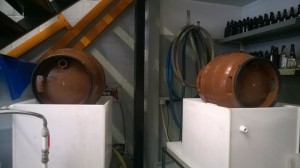Right now, the hottest trend in brewing both sides of the Atlantic is the hazy, juicy style of pale hoppy beer that has come to be known New England IPA or ‘NEIPA’. There has been a trend towards IPA that is less bitter, less caramel-chewy for quite a while now. All those rasping, bittering arms race 100+ IBU citrus and pine bombs of the early 2010s seem old fashioned now despite being less than ten years old. I have to admit I’m not a massive fan of this style of beer. Generally, I find them to be overly sweet, underbittered and a bit one dimensional.
The rise of these beers has come from a fairly small number of breweries in the U.S., Trillium, Tree House, Other Half and Hill Farmstead and a couple of others seem to have kicked it off, but it is a style aped nationwide now. Brewers on the West Coast like Monkish have jumped on the hazewagon, with limited runs of their IPA and DIPA cans. Monkish regularly have queues of several hundred snaking down the street on ‘release days’, with people desperate to buy their six pack. In Europe there has been an explosion in brewing this style of beer too. In the UK the likes of Cloudwater, Brew By Numbers, and Magic Rock have all brewed deliberately hazed IPAs. Verdant and more recently Deya have based almost their whole business around brewing juicy, tropical, hazy IPA and pale ale. Further afield, Omnipollo, Dugges, Brewski, and Stigbergets are making the same style beer. Clearly this beer is very much in demand.
Typically this kind of beer is fairly poorly attenuated and has lots of residual sweetness, along with a rich, thick, creamy body, low bitterness and a heady, tropical aroma of mango, peach and lychee.
What is this haze that these brewers are trying to capture in their beer then? Haze can be a few things really that either come from the wort production or from the fermentation stage of production. All of the below, depending on the beer can be a factor.
- Firstly, yeast. The use of non-flocculant yeast such as the Vermont strain favoured by many NEIPA brewers doesn’t drop out of solution particularly quickly or easily, meaning it can still be present in packaging. The Vermont strain also throws lots of peachy esters which compliment the tropical hop aromas. Too much yeast left in solution can add nasty tangy flavours as well as autolysed off flavours if left too long.
- Secondly, beta glucans. Beta glucans are polysaccharides of D-glucose monomers that have β-glycocidic bonds. Many brewers will do a β-glucanase rest after mashing in at around 40 degrees C to allow enzymes present in the barley malt to break down these gummy molecules. Oats, wheat and rye are all much higher in β-glucans than malted barley, and without a β-glucanase rest are run off from the mash and remain in the finished beer. Β-glucans increase not only the haziness of the beer but also the viscosity and in turn enrich the mouthfeel. Lots of brewers of NEIPA will add anything between 30-40% oats in the grist for their beers.
- Polyphenols. These complex molecules can enter the brewing process at both the start and end of the process. Tannins in the grain husk and are washed out of the malt during sparging. A small quantity tannin is usually a good thing as when the wort is boiled they bond with protein molecules to form the hot break in the kettle. Too many and the beer can become astringent and drying in the mouth. Think the tongue sapping character of stewed tea or rough unaged red wine. Secondly, polyphenols can come from the dry hopping of beers, especially when the dry hopping is very heavy. Normal IPA hopping would be somewhere between 5-7g/l but many NEIPA producers are using upwards of 20g/l. Polyphenol haze especially from dry hopping is accentuated when the beer is cold so, is sometimes referred to as ‘chill haze’.
- Malted barley is comprised of between 10-11% protein, of this only around 20% of these are soluble in water. The rest, if not coagulated in the boil or cooldown will be present in the finished beer.
- Other stuff. Some producers are adding wheat flour to their NEIPA to create a stable protein haze. Pectin too, can be used to haze things permanently. Pectin occurs naturally in fruit and is a gelling agent that allows things like jellies and jams to set. It also throws a heavy haze. Apples are the fruit richest in pectins, which is why many farmhouse ciders are so cloudy. Some NEIPA producers are adding apple concentrate to give a stable haze to their beers too. Pectin also adds viscosity to a liquid which again enriches and smoothens the mouthfeel.

(Picture via Daniel Vane @DanielVane)
Some of these beers have had some production, stability and quality issues. The recent Brewdog vs Cloudwater NEIPA for example has had quite a few people open their bottles to be surprised by wodges of hop and protein trub. This is really not what this kind of beer is about. More ‘bits’ in the beer doesn’t mean more desirable flavours. JK from Marble has a great analogy for the inclusion of hop and protein trub in beers. His argument is that if you were to eat a banana, skin and all, it would taste more accurately of banana, but would you actually want the flavour of the banana skin? Almost definitely not. The inclusion of hop, protein and yeast trub is essentially that.
It is pretty clear that there is very little flavour imparted by the haze itself, though the flavour of hop polyphenols is widely and inconclusively debated. All the haze does is add mouthfeel to the beer, that creamy body that so many people mention in their tasting notes of this type of beer. For me at least the haze seems to muddy the hop flavours. They don’t sing and dance with the same brightness as they do in beers with greater clarity. It seems to be harder to pick out individual flavours and aromas in these kinds of beers. Perhaps it is because broadly, they all using very similar combinations of hops that all contribute the same aromas and flavours. I think the sweetness in some of these beers also makes flavours harder to pick out too, especially as some producers have been adding unfermentable lactose to their pale beer to further sweeten and ‘juicify’ them. That said there are a few exceptions, the latest Brew By Numbers ‘55’ DIPA is an absolute masterpiece of juice, bitterness and smooth mouthfeel. Deya’s cans that I have tried are well balanced and bitter enough to make them drinkable, rather than cloying.
I think this haze phase will pass just as the raspingly bitter IPA did before it, we’ll find something new and exciting to try that I hope, to my tastes at least, will be much more drinkable….





























